Crystal forms of tetrahydro-n,n-dimethyl-2,2-diphenyl-3-furanmethanamine hydrochloride, processes of making such forms, and their pharmaceutical compositions
Daintree , et al. April 6, 2
U.S. patent number 10,966,952 [Application Number 16/525,319] was granted by the patent office on 2021-04-06 for crystal forms of tetrahydro-n,n-dimethyl-2,2-diphenyl-3-furanmethanamine hydrochloride, processes of making such forms, and their pharmaceutical compositions. This patent grant is currently assigned to ANAVEX LIFE SCIENCES CORP.. The grantee listed for this patent is ANAVEX LIFE SCIENCES CORP.. Invention is credited to Linda Sharon Daintree, Daniel Mark Ledger, Lucy Anne Leonard, Peter York.
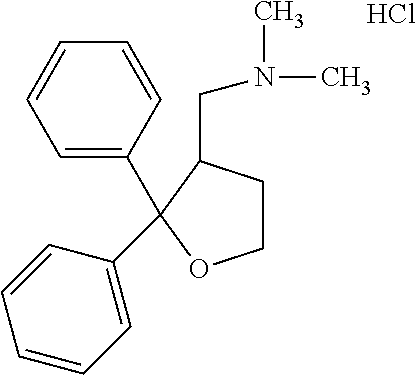
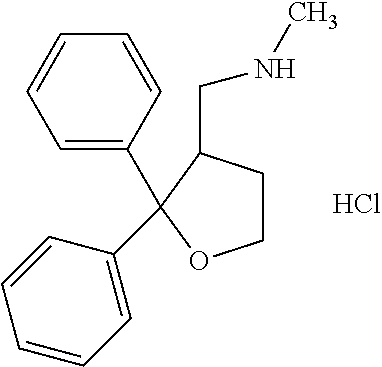




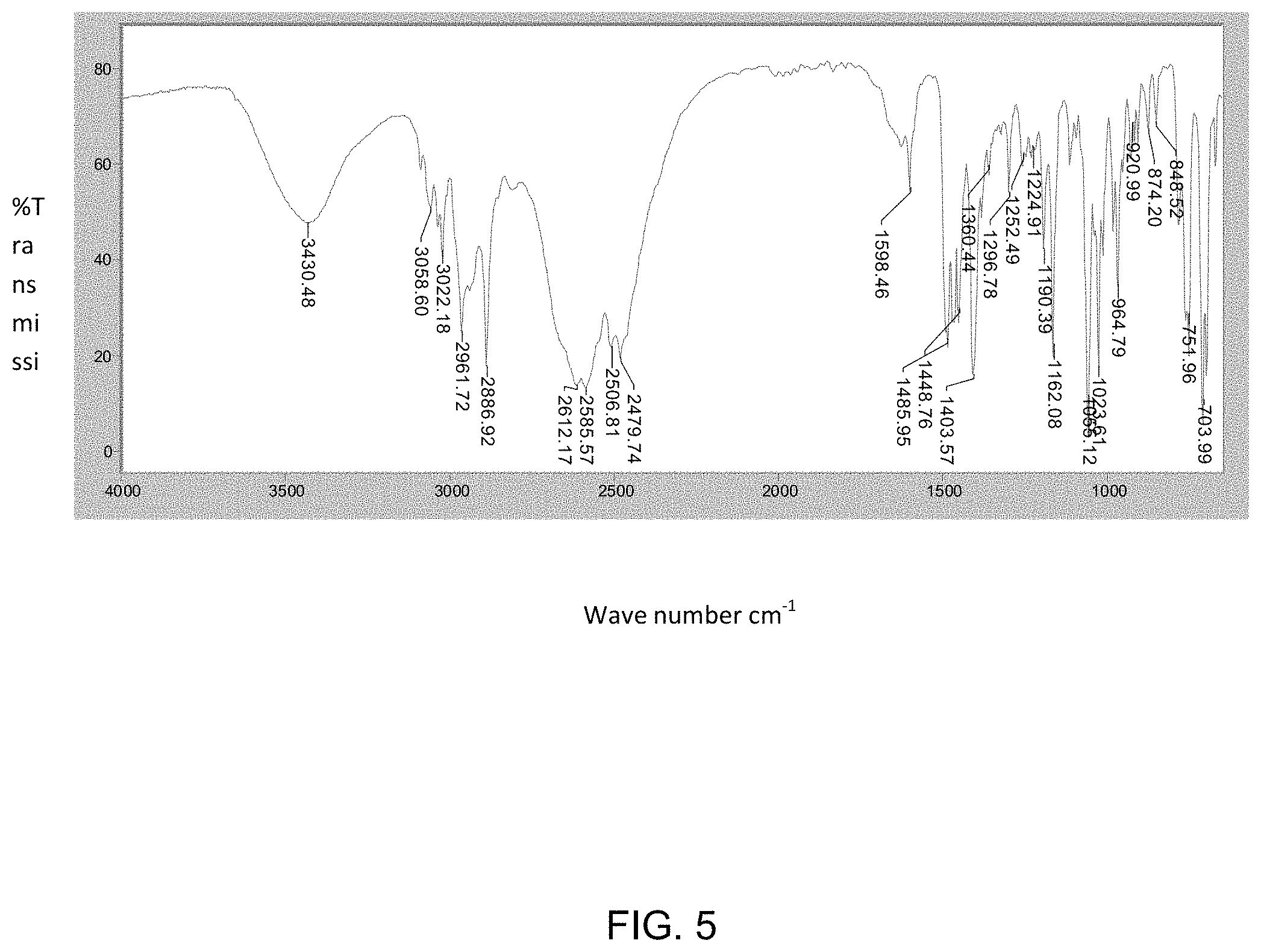
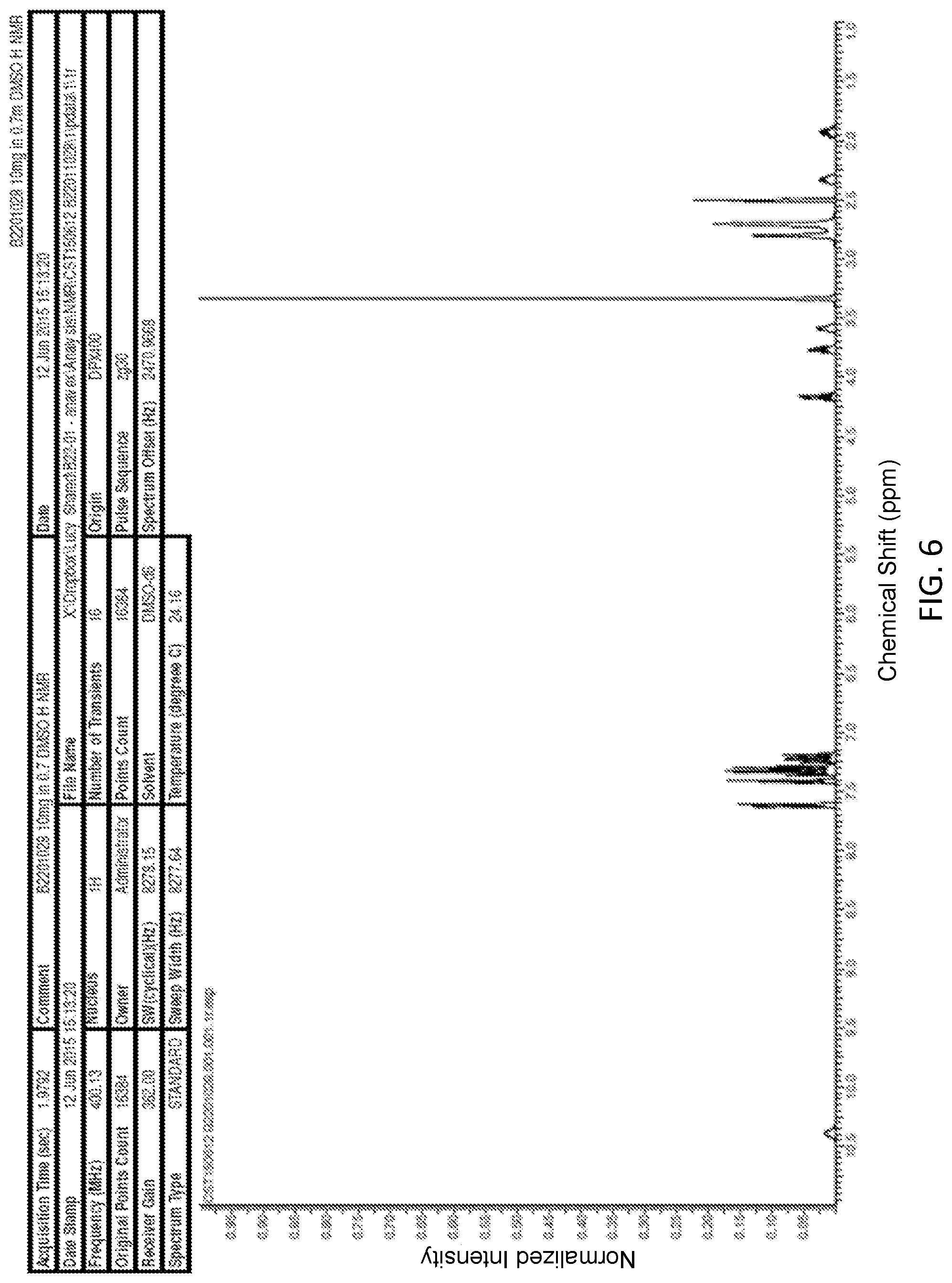


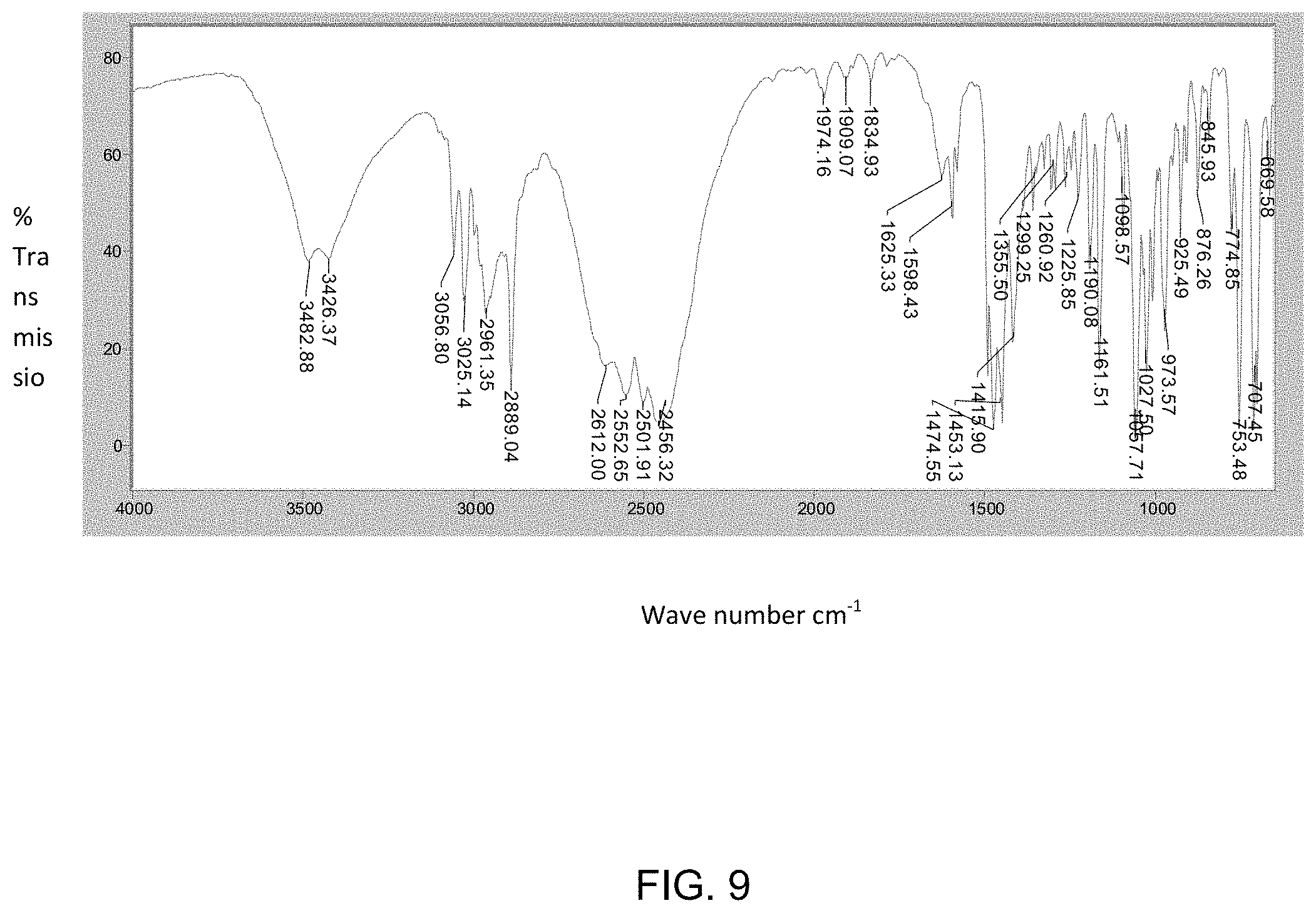
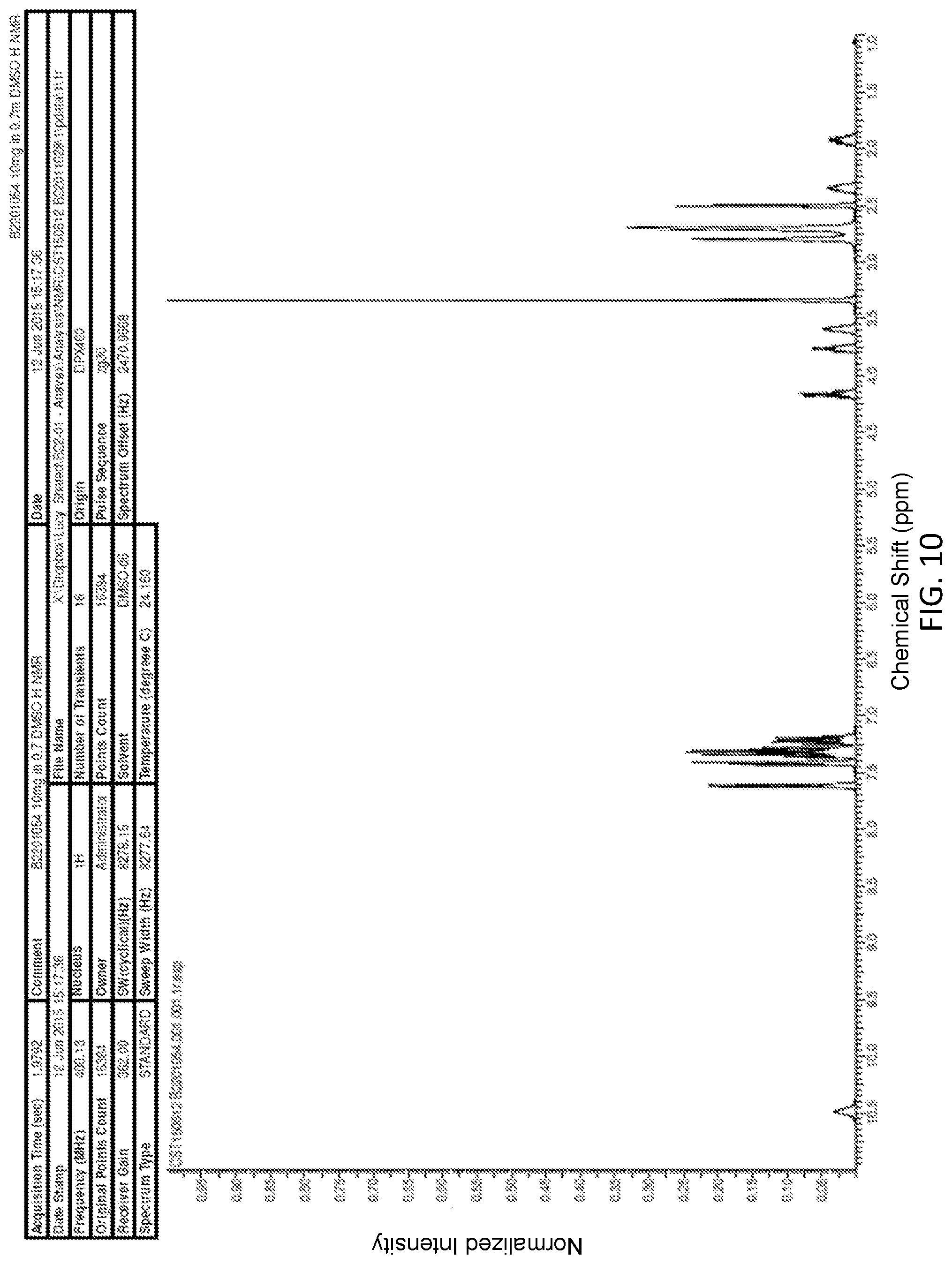
View All Diagrams
| United States Patent | 10,966,952 |
| Daintree , et al. | April 6, 2021 |
Crystal forms of tetrahydro-n,n-dimethyl-2,2-diphenyl-3-furanmethanamine hydrochloride, processes of making such forms, and their pharmaceutical compositions
Abstract
Polymorphic forms of tetrahydro-N,N-dimethyl-2,2-diphenyl-3-furanmethanamine hydrochloride (ANAVEX2-73) and a metabolite of tetrahydro-N,N-dimethyl-2,2-diphenyl-3-furanmethanamine hydrochloride (ANAVEX2-73) are disclosed and characterized. Compositions and method for treatment of Alzheimer's disease that includes the polymorphic forms and metabolite of tetrahydro-N,N-dimethyl-2,2-diphenyl-3-furanmethanamine hydrochloride (ANAVEX2-73).
| Inventors: | Daintree; Linda Sharon (Leeds, GB), Ledger; Daniel Mark (Bradford, GB), Leonard; Lucy Anne (Bradford, GB), York; Peter (Bradford, GB) | ||||||||||
|---|---|---|---|---|---|---|---|---|---|---|---|
| Applicant: |
|
||||||||||
| Assignee: | ANAVEX LIFE SCIENCES CORP. (New
York, NY) |
||||||||||
| Family ID: | 1000005467215 | ||||||||||
| Appl. No.: | 16/525,319 | ||||||||||
| Filed: | July 29, 2019 |
Prior Publication Data
| Document Identifier | Publication Date | |
|---|---|---|
| US 20190350892 A1 | Nov 21, 2019 | |
Related U.S. Patent Documents
| Application Number | Filing Date | Patent Number | Issue Date | ||
|---|---|---|---|---|---|
| 15579705 | 10413519 | ||||
| PCT/IB2016/001181 | Jul 19, 2016 | ||||
| 62195486 | Jul 22, 2015 | ||||
| Current U.S. Class: | 1/1 |
| Current CPC Class: | B01D 9/005 (20130101); B01D 11/0403 (20130101); A61P 25/28 (20180101); C07D 307/14 (20130101); A61K 31/341 (20130101) |
| Current International Class: | A61K 31/341 (20060101); C07D 307/14 (20060101); A61P 25/28 (20060101); B01D 9/00 (20060101); B01D 11/04 (20060101) |
| 97/30983 | Aug 1997 | WO | |||
| 2010/097641 | Sep 2010 | WO | |||
| 2013/008044 | Jan 2013 | WO | |||
| WO 2013/008044 | Jan 2013 | WO | |||
| 2014/155138 | Oct 2014 | WO | |||
Other References
|
Villard et al. (J Psychopharmacol. Aug. 2011;25(8):1101-17). cited by examiner . International Search Report and Written Opinion dated Jan. 1, 2017 in corresponding International Application No. PCT/IB2016/001181. cited by applicant . Bouchard, A. et al., "Ways of Manipulating the Polymorphism of Glycine During Supercritical Fluid Crystallisation," The Journal of Supercritical Fluids, vol. 44, No. 3, pp. 422-432 (Apr. 2008). cited by applicant . Bryn, S. et al., "Pharmaceutical Solids: A Strategic Approach to Regulatory Consideration," Pharmaceutical Research, vol. 12, No. 7, pp. 945-954 (Aug. 1995). cited by applicant . Foscolos, G. B. et al., "Synthesis and Pharmacological Study of Some new beta-(dialkylaminomethyl)-gamma-butyrolact ones and their Tetrahydrofuran Analogs," IL Farmaco, vol. No. 15, No. 1, pp. 19-26 (Feb. 1996). cited by applicant . Lahmy, V. et al., "Blockade of Tau Hyperphosphorylation and a beta 1-42 Generation by the Aminotetrahydrofuran Derivative ANAVEX2-73, a mixed Muscarinic and Gammal Receptor Agonist, in a Nontransgenic Mouse Model of Alzheimer's Disease," Neurophychopharmacology, vol. 38, No. 9, pp. 1706-1723 (Aug. 2013). cited by applicant . Villard, V. et al., "Anti-Amnesic and Neuroprotective Potentials of the Mixed Muscarinic Receptor/Signal Ligand ANAVEX2-73, a Novel Aminotetrahydrofuran Derivative," Journal of Psycopharmacology, vol. 25, No. 8, pp. 1101-1117 (Aug. 2011). cited by applicant . Extended European Search Report dated Jan. 3, 2019 in corresponding European Patent Application No. 16827324.1. cited by applicant. |
Primary Examiner: Rodriguez-Garcia; Valerie
Attorney, Agent or Firm: Nealey; Tara A. Yang; Rong
Parent Case Text
CROSS REFERENCED TO RELATED APPLICATIONS
This application is a divisional of U.S. patent application Ser. No. 15/579,705 filed Dec. 5, 2017, which is the 35 U.S.C. 371 National Stage of International Application Number PCT/IB2016/001181, filed Jul. 19, 2016, which claims priority from U.S. Provisional Patent Application No. 62/195,486 filed Jul. 22, 2015, the contents of which are incorporated herein by reference.
Claims
What is claimed is:
1. A crystalline form of ANAVEX19-144 characterized by the PXRD pattern shown in FIG. 12.
2. The crystalline form of ANAVEX19-144 of claim 1, further characterized by the DSC-TGA data shown in FIG. 13 and the FTIR spectrum shown in FIG. 14.
3. The crystalline form of ANAVEX19-144 of claim 1, further characterized by particle size and morphology as depicted in FIG. 15.
4. The crystalline form of ANAVEX19-144 of claim 1, wherein the habit is needle-like.
5. A method of preparing the crystalline form of ANAVEX19-144 of claim 1 comprising: (a) preparing a solution of ANAVEX19-144 in a solvent; (b) introducing the solution to a supercritical fluid (SCF) environment comprising supercritical CO.sub.2 in a pressure vessel; and (c) manipulating process parameters of the SCF to produce the crystalline form of ANAVEX19-144 of claim 1; wherein the solvent is ethanol; and wherein the process parameters include pressure vessel at a pressure of 200 bars, a temperature at 80.degree. C., a flow rate of supercritical CO.sub.2 at 20 g/min, and a TS flow of 0.4 mL/min.
6. A neuroprotective dosage form comprising the crystalline form of ANAVEX19-144 of claim 1.
7. A pharmaceutical composition for the treatment of Alzheimer's disease comprising the crystalline form of ANAVEX19-144 of claim 1.
8. A method of treating Alzheimer's disease in a subject comprising administrating to the subject the neuroprotective dosage form of claim 6.
9. A crystalline form of ANAVEX19-144 characterized by the PXRD pattern shown in FIG. 17.
10. The crystalline form of ANAVEX19-144 of claim 9, further characterized by the DSC-TGA data shown in FIG. 18.
11. The crystalline form of ANAVEX19-144 of claim 9, characterized by particle size and morphology as depicted in FIG. 16.
12. A method of preparing the crystalline form of ANAVEX19-144 of claim 9, comprising: (a) preparing a solution of ANAVEX19-144 in a solvent; (b) introducing the solution of ANAVEX19-144 to a supercritical fluid (SCF) environment comprising supercritical CO.sub.2 in a pressure vessel; and (c) manipulating process parameters of SCF to obtain the crystalline form of ANAVEX19-144 of claim 9; wherein the solvent is dichloromethane; and wherein the process parameters include pressure vessel at a pressure of 200 bars, a temperature at 80.degree. C., a flow rate of supercritical CO.sub.2 at 20 g/min, and a TS flow of 0.4 mL/min.
13. A neuroprotective dosage form comprising the crystalline form of ANAVEX19-144 of claim 9.
14. A pharmaceutical composition for the treatment of Alzheimer's disease comprising the crystalline form of ANAVEX19-144 of claim 9.
15. A method of treating Alzheimer's disease in a subject comprising administrating to the subject the neuroprotective dosage form of claim 13.
Description
FIELD
The present disclosure is directed to crystalline forms of tetrahydro-N,N-dimethyl-2,2-diphenyl-3-furanmethanamine hydrochloride, as well as compositions, processes of preparation, and uses thereof.
BACKGROUND
Because improved drug formulations showing, for example, better bioavailability or better stability are consistently sought, there is an ongoing need for more fully characterized, new, polymorphic and derivative forms of drug molecules. Characterization of tetrahydro-N,N-dimethyl-2,2-diphenyl-3-furanmethanamine hydrochloride, and crystalline polymorphs and a metabolite of tetrahydro-N,N-dimethyl-2,2-diphenyl-3-furanmethanamine hydrochloride are described herein toward this end.
SUMMARY OF THE PRESENT DISCLOSURE
The present disclosure comprises crystalline forms of tetrahydro-N,N-dimethyl-2,2-diphenyl-3-furanmethanamine hydrochloride characterized by the PXRD pattern shown in FIG. 1, FIG. 4, or FIG. 8. The crystalline forms are further characterized by the FTIR spectrum shown in FIG. 5 or FIG. 9. The crystalline forms are further characterized by the .sup.1H-NMR spectrum shown in FIG. 6 or FIG. 10. The crystalline forms are further characterized by the particle shapes depicted in FIG. 2, FIG. 3, FIG. 7 or FIG. 11. The crystalline forms are further characterized by the particle sizes depicted in FIG. 2, FIG. 3, FIG. 7 or FIG. 11. The crystalline forms can have a plate-like habit. The crystalline forms can also have a needle-like habit. The crystalline forms can have a lath-like habit. Further included, is a method of making the crystalline forms using a supercritical fluid (SCF) technique. Further included is a dosage form comprising a therapeutically neuroprotective amount of the crystalline forms. Further included is a pharmaceutical composition for the treatment of Alzheimer's disease comprising a therapeutically effective amount of the crystalline forms. Further included is a method of treating Alzheimer's disease in a subject comprising administering to the subject a therapeutically effective amount of the crystalline forms.
The present disclosure also comprises crystalline Form I of tetrahydro-N,N-dimethyl-2,2-diphenyl-3-furanmethanamine hydrochloride characterized by the PXRD pattern shown in FIG. 1. The crystalline Form I according is also characterized by the particle shapes as depicted in FIG. 2. The crystalline Form I is also characterized by the particle shapes as depicted in FIG. 3. The crystalline Form I is also characterized by the particle sizes as depicted in FIG. 2. The crystalline Form I is also characterized by the particle sizes as depicted in FIG. 3. Crystalline Form I is also characterized by a plate-like habit. Further included is a method of making crystalline Form I using a supercritical fluid (SCF) technique. Further included is a dosage form comprising a therapeutically neuroprotective amount of crystalline Form I. Further included is a pharmaceutical composition for the treatment of Alzheimer's disease comprising a therapeutically effective amount of crystalline Form I. Further included is a method of treating Alzheimer's disease in a subject comprising administering to the subject a therapeutically effective amount of the crystalline Form I.
The present disclosure also comprises crystalline Form II of tetrahydro-N,N-dimethyl-2,2-diphenyl-3-furanmethanamine hydrochloride characterized by the PXRD pattern shown in FIG. 4. Crystalline Form II is also characterized by the FTIR spectrum shown in FIG. 5. Crystalline Form II is also characterized by the .sup.1H-NMR spectrum shown in FIG. 6. Crystalline Form II is also characterized by particle shapes as depicted in FIG. 7. Crystalline Form II is also characterized by particle sizes as depicted in FIG. 7. Crystalline Form II can also have a plate-like habit. Further included is a method of making crystalline Form II using a supercritical fluid (SCF) technique. Further included is a dosage form comprising a therapeutically neuroprotective amount of crystalline Form II. Further included is a pharmaceutical composition for the treatment of Alzheimer's disease comprising a therapeutically effective amount of crystalline Form II. Further included is a method of treating Alzheimer's disease in a subject comprising administering to the subject a therapeutically effective amount of crystalline Form II.
The present disclosure also comprises crystalline Form III of tetrahydro-N,N-dimethyl-2,2-diphenyl-3-furanmethanamine hydrochloride characterized by the PXRD pattern shown in FIG. 8. Crystalline Form III is also characterized by the FTIR spectrum shown in FIG. 9. Crystalline Form III is also characterized by the .sup.1H-NMR spectrum shown in FIG. 10. Crystalline Form III is also characterized by particle shapes as depicted in FIG. 11. Crystalline Form III is also characterized by particle sizes as depicted in FIG. 11. Crystalline Form III can also have a lath-like habit. Further included is a method of making crystalline Form III using a supercritical fluid (SCF) technique. Further included is a dosage form comprising a therapeutically neuroprotective amount of crystalline Form III. Further included is a pharmaceutical composition for the treatment of Alzheimer's disease comprising a therapeutically effective amount of crystalline Form III. Further included is a method of treating Alzheimer's disease in a subject comprising administering to the subject a therapeutically effective amount of crystalline Form III.
The present disclosure also comprises metabolite ANAVEX19-144 characterized by the PXRD pattern shown in FIG. 12. Metabolite ANAVEX19-144 is also characterized by the DSC-TGA data shown in FIG. 13. Metabolite ANAVEX19-144 is also characterized by the FTIR spectrum shown in FIG. 14. Metabolite ANAVEX19-144 can also be characterized by particle shapes as depicted in FIG. 15. Metabolite ANAVEX19-144 can also be characterized by particle sizes as depicted in FIG. 15. Metabolite ANAVEX19-144 can also have a needle-like habit. Further included is a method of making the metabolite ANAVEX19-144 using a supercritical fluid (SCF) technique. Further included is a dosage form comprising a therapeutically neuroprotective amount of the metabolite ANAVEX19-144. Further included is a pharmaceutical composition for the treatment of Alzheimer's disease comprising a therapeutically effective amount of the metabolite ANAVEX19-144. Further included is a method of treating Alzheimer's disease in a subject comprising administering to the subject a therapeutically effective amount of the metabolite ANAVEX19-144.
The present disclosure also comprises metabolite ANAVEX19-144 characterized by the PXRD pattern shown in FIG. 17. Metabolite ANAVEX19-144 is also characterized by the DSC-TGA data shown in FIG. 18. Metabolite ANAVEX19-144 can also be characterized by particle shapes as depicted in FIG. 16. Metabolite ANAVEX19-144 can also be characterized by particle sizes as depicted in FIG. 16. Further included is a method of making the metabolite ANAVEX19-144 using a supercritical fluid (SCF) technique. Further included is a dosage form comprising a therapeutically neuroprotective amount of metabolite ANAVEX19-144. Further included is a pharmaceutical composition for the treatment of Alzheimer's disease comprising a therapeutically effective amount of metabolite ANAVEX19-144. Further included is a method of treating Alzheimer's disease in a subject comprising administering to the subject a therapeutically effective amount of metabolite ANAVEX19-144.
BRIEF DESCRIPTION OF THE DRAWINGS
In order to describe the manner in which the advantages and features of the disclosure can be obtained, reference is made to embodiments thereof which are illustrated in the appended drawings. Understanding that these drawings depict only exemplary embodiments of the disclosure and are not therefore to be considered to be limiting of its scope, the principles herein are described and explained with additional specificity and detail through the use of the accompanying drawings in which:
FIG. 1 depicts a powder X-ray diffraction (PXRD) pattern characteristic of polymorph Form I of tetrahydro-N,N-dimethyl-2,2-diphenyl-3-furanmethanamine hydrochloride (ANAVEX2-73);
FIG. 2 depicts scanning electron microscope (SEM) micrographs demonstrating the size and morphology of particles of polymorph Form 1 of tetrahydro-N,N-dimethyl-2,2-diphenyl-3-furanmethanamine hydrochloride (ANAVEX2-73) produced using acetonitrile as the solvent in the supercritical fluid process;
FIG. 3 depicts SEM micrographs demonstrating the size and morphology of particles of polymorph Form 1 of tetrahydro-N,N-dimethyl-2,2-diphenyl-3-furanmethanamine hydrochloride (ANAVEX2-73) produced using ethanol as the solvent in the supercritical fluid process;
FIG. 4 depicts a PXRD pattern characteristic of polymorph Form II of tetrahydro-N,N-dimethyl-2,2-diphenyl-3-furanmethanamine hydrochloride (ANAVEX2-73);
FIG. 5 depicts a fourier transform infrared (FTIR) spectrum characteristic of polymorph Form II of tetrahydro-N,N-dimethyl-2,2-diphenyl-3-furanmethanamine hydrochloride (ANAVEX2-73);
FIG. 6 depicts a proton nuclear magnetic resonance (.sup.1H-NMR) spectrum characteristic of polymorph Form II of tetrahydro-N,N-dimethyl-2,2-diphenyl-3-furanmethanamine hydrochloride (ANAVEX2-73);
FIG. 7 depicts SEM micrographs demonstrating the size and morphology of particles of polymorph Form II of tetrahydro-N,N-dimethyl-2,2-diphenyl-3-furanmethanamine hydrochloride (ANAVEX2-73);
FIG. 8 depicts a PXRD pattern characteristic of polymorph Form III of tetrahydro-N,N-dimethyl-2,2-diphenyl-3-furanmethanamine hydrochloride (ANAVEX2-73);
FIG. 9 depicts an FTIR spectrum characteristic of polymorph Form III of tetrahydro-N,N-dimethyl-2,2-diphenyl-3-furanmethanamine hydrochloride (ANAVEX2-73);
FIG. 10 depicts a .sup.1H-NMR spectrum characteristic of polymorph Form III of tetrahydro-N,N-dimethyl-2,2-diphenyl-3-furanmethanamine hydrochloride (ANAVEX2-73);
FIG. 11 depicts SEM micrographs demonstrating the size and morphology of particles of polymorph Form III of tetrahydro-N,N-dimethyl-2,2-diphenyl-3-furanmethanamine hydrochloride (ANAVEX2-73);
FIG. 12 depicts a PXRD pattern characteristic of metabolite ANAVEX19-144 produced using ethanol as the solvent in the supercritical fluid process;
FIG. 13 depicts DSC-TGA data characteristic of metabolite ANAVEX19-144 produced using ethanol as the solvent in the supercritical fluid process;
FIG. 14 depicts a FTIR spectrum characteristic of metabolite ANAVEX19-144 produced using ethanol as the solvent in the supercritical fluid process;
FIG. 15 depicts SEM micrographs demonstrating the size and morphology of particles of metabolite ANAVEX19-144 produced using ethanol as the solvent in the supercritical fluid process;
FIG. 16 depicts SEM micrographs demonstrating the size and morphology of particles of metabolite ANAVEX19-144 produced using dichloromethane as the solvent in the supercritical fluid process;
FIG. 17 depicts a PXRD pattern characteristic of metabolite ANAVEX19-144 produced using dichloromethane as the solvent in the supercritical fluid process; and
FIG. 18 depicts DSC-TGA data characteristic of metabolite ANAVEX19-144 produced using dichloromethane as the solvent in the supercritical fluid process.
DETAILED DESCRIPTION
Various embodiments of the disclosure are discussed in detail below. While specific implementations are discussed, it should be understood that this is done for illustration purposes only. A person skilled in the relevant art will recognize that other components and configurations may be used without parting from the spirit and scope of the disclosure.
It should be understood at the outset that although illustrative implementations of one or more embodiments are illustrated below, the disclosed method may be implemented using any number of techniques. The disclosure should in no way be limited to the illustrative implementations, drawings, and techniques illustrated herein, but may be modified within the scope of the appended claims along with their full scope of equivalents.
In the following discussion and in the claims, the terms "including" and "comprising" are used in an open-ended fashion, and thus should be interpreted to mean "including, but not limited to . . . ". The various characteristics described in more detail below, will be readily apparent to those skilled in the art with the aid of this disclosure upon reading the following detailed description, and by referring to the accompanying drawings.
The present disclosure relates to tetrahydro-N,N-dimethyl-2,2-diphenyl-3-furanmethanamine hydrochloride, also referred to as ANAVEX2-73:
##STR00001##
It has been reported that ANAVEX2-73 shows neuroprotective potential against amyloid toxicity in mice. In particular, ANAVEX2-73 has been reported as attenuating oxidative stress, caspases induction, cellular loss and learning and memory deficits observed in mice one week after the i.c.v. injection of an oligomeric preparation of amyloid .sub.25-35 peptide (A.beta..sub.25-35). See J. Psychopharmacol. 25(8), 1101-1117 (2011). More recently, it has been reported that ANAVEX2-73 blocked the A.beta..sub.25-35-induced P-Akt decrease and P-GSK-3.beta. increase, indicating activation at the PI3K neuroprotective pathway. See Neuropsychopharmacology 38, 1706-1723 (2013). In the dose-range tested, ANAVEX2-73 attenuated the hyperphosphorylation of Tau on physiological epitopes (AT-8 antibody clone) and on pathological epitopes (AT-100 clone). ANAVEX2-73 also has been reported to decrease the A.beta..sub.25-35-induced endogenous A.beta..sub.1-42 seeding.
Reference is made to U.S. Patent Publication No. 2014/0296211 entitled "ANAVEX2-73 AND CERTAIN ANTICHOLINESTERASE INHIBITORS COMPOSITION AND METHOD FOR NEUROPROTECTION," to Vamvakides et al., filed Jul. 12, 2013; U.S. Ser. No. 62/065,833 entitled "A19-144, A2-73 AND CERTAIN ANTICHOLINESTERASE INHIBITOR COMPOSITIONS AND METHOD FOR ANTI-SEIZURE THERAPY," filed Oct. 20, 2014; U.S. patent application entitled "ANAVEX2-73 FOR THE TREATMENT OF ALZHEIMER'S DISEASE" and filed on date even herewith; U.S. patent application entitled "ENANTIOMERS OF A2-73, ANALOGUES, AND SIGMA AGONIST ACTIVITY" and filed on date even herewith. The teaching of these applications and publications and all references cited herein are incorporated by reference in their entirety.
The present disclosure, provides a crystalline polymorph (Form I) of tetrahydro-N,N-dimethyl-2,2-diphenyl-3-furanmethanamine hydrochloride, characterized by PXRD and other data provided herein.
The present disclosure provides another crystalline polymorph (Form II) of tetrahydro-N,N-dimethyl-2,2-diphenyl-3-furanmethanamine hydrochloride characterized by the PXRD and other data provided herein.
The present disclosure further provides another crystalline polymorph (Form III) of tetrahydro-N,N-dimethyl-2,2-diphenyl-3-furanmethanamine hydrochloride characterized by the PXRD and other data provided herein.
The present disclosure also provides a metabolite of tetrahydro-N,N-dimethyl-2,2-diphenyl-3-furanmethanamine hydrochloride, referred to as ANAVEX19-144, characterized by the PXRD and other data provided herein and having the structure:
##STR00002##
The present disclosure further provides use of the polymorphs and metabolite material in the treatment of Alzheimer's disease.
Tetrahydro-N,N-dimethyl-2,2-diphenyl-3-furanmethanamine hydrochloride (ANAVEX2-73) was characterized by powder X-ray diffraction (PXRD), thermogravimetric analysis (TGA), differential scanning calorimetry (DSC), fourier transform infrared (FTIR) spectroscopy, proton nuclear magnetic resonance (.sup.1H-NMR) and scanning electron microscopy (SEM), as detailed in FIGS. 1-15.
The present disclosure further provides processes of preparing the polymorphic forms of tetrahydro-N,N-dimethyl-2,2-diphenyl-3-furanmethanamine hydrochloride (ANAVEX2-73). In one embodiment, the polymorphic forms, disclosed herein, can be prepared by a supercritical fluid (SCF) anti-solvent process. In an embodiment, the anti-solvent is a supercritical fluid, although in some embodiments near-critical fluids may also be suitable. A "supercritical fluid" is a fluid at or above its critical pressure (Pc) and critical temperature (Tc) simultaneously. In practice, the pressure of the fluid is likely to be in the range between 1.01 and 7.0 of its critical pressure, and its temperature in the range between 1.01 and 4.0 of its critical temperature (in Kelvin). However, some fluids (e.g., helium and neon) have particularly low critical pressures and temperatures, 10 and may need to be used under operating conditions well in excess of those critical values, such as up to 200 times the relevant critical value. The term "near-critical fluid" encompasses both high pressure liquids, which are fluids at or above their critical pressure but below (although preferably close to) their critical temperature, and dense vapors, which are fluids at or above their critical 15 temperature but below (although preferably close to) their critical pressure. By way of example, a high pressure liquid might have a pressure between about 1.01 and 7 times its Pc, and a temperature between about 0.5 and 0.99 times its Tc. A dense vapor might, correspondingly, have a pressure between about 0.5 and 0.99 times its Pc, and a temperature between about 1.01 and 4 times its Tc.
Suitably, the anti-solvent and solution may be introduced into a precipitation chamber via respective passages with respective outlets, the outlets being arranged relative to one another such that anti-solvent introduced through a first passage and solution introduced through a second passage both enter the precipitation chamber at substantially the same point, which is substantially the point at which the anti-solvent and solution meet. To provide for good levels of mixing and dispersion, the anti-solvent and the solution may, for example, be co-fed into a precipitation chamber via a nozzle having co-axial passages which terminate adjacent to one another. Alternatively, one or more streams of the antisolvent may be arranged to impinge on a stream of the solution to provide good levels of mixing and dispersion. However, other mixing architectures are also possible. Examples of suitable apparatus are known, inter alia, from WO-30 95/01221, WO-96/00610, WO-98/36825, WO-99/44733, WO-99/59710, WO-01/03821, and WO-03/008082, which are incorporated herein by reference.
According to the present disclosure, new crystalline forms of tetrahydro-N,N-dimethyl-2,2-diphenyl-3-furanmethanamine hydrochloride (ANAVEX2-73) were prepared by a supercritical fluid (SCF) process. The basic process involved preparing a solution of tetrahydro-N,N-dimethyl-2,2-diphenyl-3-furanmethanamine hydrochloride (ANAVEX2-73) in a suitable solvent, such as acetonitrile or ethanol, and introducing the solution to an SCF environment, typically supercritical CO.sub.2, in a pressure vessel. The supercritical CO.sub.2 acted as a powerful antisolvent allowing particles to be rapidly precipitated. Different polymorphic forms of tetrahydro-N,N-dimethyl-2,2-diphenyl-3-furanmethanamine hydrochloride (ANAVEX2-73) were produced by manipulating SCF process parameters, including the solvent used, flow rate, pressure, and temperature. Additionally, manipulation of SCF process parameters determined the size, morphology, and habit of crystalline particles produced by the SCF process.
The SCF process parameters used to produce the three polymorphic forms of tetrahydro-N,N-dimethyl-2,2-diphenyl-3-furanmethanamine hydrochloride (ANAVEX2-73), Forms I-III, are provided in Tables 1-3. As shown in Table 1, crystalline Form I was produced by placing the ANAVEX2-73 starting material in a solvent of acetonitrile or ethanol and processed by the supercritical fluid technique. The resulting particle shape differed depending upon the solvent. The particle shape for the crystalline Form I produced using acetonitrile solvent was plate-like. As used herein, the term "plate-like" refers to a flat particle of similar length and width. The particle shape for the crystalline Form I produced using ethanol solvent was a conglomerate. As used herein, the term "conglomerate" refers to a mixture of two or more types of particle shapes. The resulting material was characterized by PXRD and SEM. The PXRD for crystalline Form I of ANAVEX2-73 is shown in FIG. 1. SEM micrographs showing the particle size and morphology of crystalline Form I are shown in FIGS. 2-3. FIG. 2 shows the particle size and morphology of crystalline Form I produced using acetonitrile solvent (plate-like morphology). FIG. 3 shows the particle size and morphology of crystalline Form I produced using ethanol as the solvent (conglomerate morphology).
As shown in Table 2, crystalline Form II was produced by placing the ANAVEX2-73 starting material in a solvent of acetonitrile, 1:9 v/v trifluoroethanol+ethanol, 1:1 v/v acetone+ethanol, or 3-methyl-1-butanol, and processed by the supercritical fluid technique. In all cases, crystalline Form II was characterized by a plate-like habit. The resulting material was characterized by PXRD and SEM. The PXRD for crystalline Form II of ANAVEX2-73 is shown in FIG. 4. Crystalline Form II is further characterized by the FTIR spectrum shown in FIG. 5 and the .sup.1H-NMR shown in FIG. 6. SEM micrographs showing the particle size and morphology of crystalline Form II are shown in FIG. 7.
As shown in Table 3, crystalline Form III was produced by placing the ANAVEX2-73 starting material in a solvent of ethanol or 1:9 v/v trifluoroethanol+ethanol and processed by the supercritical fluid technique. In all cases, crystalline Form III was characterized by a lath-like habit. As used herein, "lath-like" refers to a long, thin blade-like particle. The resulting material was characterized by PXRD and SEM. The PXRD for crystalline Form III of ANAVEX2-73 is shown in FIG. 8. Crystalline Form III is further characterized by the FTIR spectrum shown in FIG. 9 and the .sup.1H-NMR shown in FIG. 10. SEM micrographs showing the particle size and morphology of crystalline Form III are shown in FIG. 11.
TABLE-US-00001 TABLE 1 Crystalline Form I Samples Solution mole mole Mass SCF Conc P T density TS flow CO.sub.2 flow fraction fraction Ratio Particle Surface sample No Solvent (mg/ml) (bar) .degree. C. (g/cm.sup.3) (g/min) (g/min) CO.sub.2 sol Flows shape characteristics B2202022 acetonitrile 27.3 105 60 0.322 0.4716 20 0.977 0.023 42.41 plate - smooth B2202038 ethanol 40 125 80 0.318 0.0789 20 0.996 0.004 253.49 conglomerate- N/A
TABLE-US-00002 TABLE 2 Crystalline Form II Samples Solution mole mole Mass SCF Conc P T density TS flow CO.sup.2 flow fraction fraction Ratio Particle Surface sample No Solvent (mg/ml) (bar) .degree. C. (g/cm.sup.3) (g/min) (g/min) CO.sub.2 sol Flows shape characteristics B2201017 acetonitrile 27.3 85 40 0.354 0.9432 20 0.955 0.045 21.20 plate s- mooth B2201018 acetonitrile 27.3 200 40 0.84 0.9432 20 0.955 0.045 21.20 plate s- mooth B2201020 acetonitrile 27.3 200 80 0.594 0.9432 20 0.955 0.045 21.20 plate - smooth B2201028 acetonitrile 27.3 85 40 0.354 1.5720 20 0.927 0.073 12.72 plate s- mooth B2201039 acetonitrile 13 105 60 0.322 1.5720 20 0.927 0.073 12.72 plate sm- ooth B2201052 1:9 v/v 50 85 40 0.354 1.0120 20 0.952 0.048 19.76 plate smooth trifluoroethanol + ethanol B2201053 1:9 v/v 50 85 40 0.354 1.0120 20 0.952 0.048 19.76 plate smooth trifluoroethanol + ethanol B2201055 1:9 v/v 50 200 40 0.84 0.1687 20 0.992 0.008 118.57 plate smooth trifluoroethanol + ethanol B2201057 1:9 v/v 20 200 40 0.84 1.6867 20 0.922 0.078 11.86 plate smooth trifluoroethanol + ethanol B2201067 1:1 v/v acetone + 50 85 40 0.354 1.5800 20 0.927 0.073 12.66 plate smooth ethanol B2201072 1:1 v/v acetone + 50 200 40 0.84 1.5800 20 0.927 0.073 12.66 plate smooth ethanol B2201076 3-methyl-1-butanol 10 85 40 0.354 0.9725 20 0.954 0.046 20.57 pla- te smooth B2201077 3-methyl-1-butanol 10 85 40 0.354 1.6208 20 0.925 0.075 12.34 pla- te smooth
TABLE-US-00003 TABLE 3 Crystalline Form III Samples Solution mole mole Mass SCF Conc P T density TS flow CO.sub.2 flow fraction fraction Ratio Particle Surface sample No Solvent (mg/ml) (bar) .degree. C. (g/cm.sup.3) (g/min) (g/min) CO.sub.2 sol Flows shape characteristics B2201011 ethanol 40 85 40 0.354 0.4734 20 0.977 0.023 42.25 lath smooth B2201036 ethanol 40 200 40 0.84 1.5780 20 0.927 0.073 12.67 lath smooth B2201054 1:9 v/v 50 85 40 0.354 0.1687 20 0.992 0.008 118.57 lath cracked trifluoroethanol + ethanol
The present disclosure also provides a metabolite of tetrahydro-N,N-dimethyl-2,2-diphenyl-3-furanmethanamine hydrochloride, ANAVEX19-144. ANAVEX19-144 has documented anti-amnesic and neuroprotective potentials similar to ANAVEX2-73. See for example J. of Psychopharmacol. 25(8), 1101-1117 (2011). Crystalline forms of ANAVEX19-144 were produced by placing the ANAVEX19-144 starting material in a solvent of ethanol or dichloromethane and processed by the supercritical fluid technique. The crystalline form of ANAVEX19-144 produced by the supercritical fluid technique under process parameters of 40 mg/mL ethanol solution, 200 bars of pressure, temperature of 80.degree. C., supercritical CO.sub.2 solution with a flow rate of 20 g/min and a TS flow of 0.4 mL/min, was characterized by PXRD, FTIR, DSC, and SEM, as shown in FIGS. 12-15. As shown in FIG. 15, the crystalline form of ANAVEX19-144 was characterized by needle-like crystals. In contrast, the crystalline form of ANAVEX19-144 produced by similar process parameters using the solvent dichloromethane exhibited a mixed habit of needle-like and lath-type particles, as shown in FIG. 16. The crystalline form of ANAVEX19-144 produced using the dichloromethane supercritical fluid technique produced a powder with better flow characteristics and improved flow properties for downstream processing. The crystalline form of ANAVEX19-144 was further characterized by PXRD and DSC, as shown in FIGS. 17-18. The two crystalline forms of ANAVEX19-144, produced according to the supercritical fluid technique in ethanol or dichloromethane were stored at 40.degree. C. at 75% relative humidity in uncapped vessels for 1 week and then characterized by PXRD to determine stability of the two forms. After one week, the PXRDs for the two forms did not show any differences and therefore indicated that the two forms were stable under the conditions tested.
* * * * *
C00001

C00002

D00001

D00002

D00003

D00004

D00005

D00006

D00007

D00008

D00009

D00010

D00011

D00012
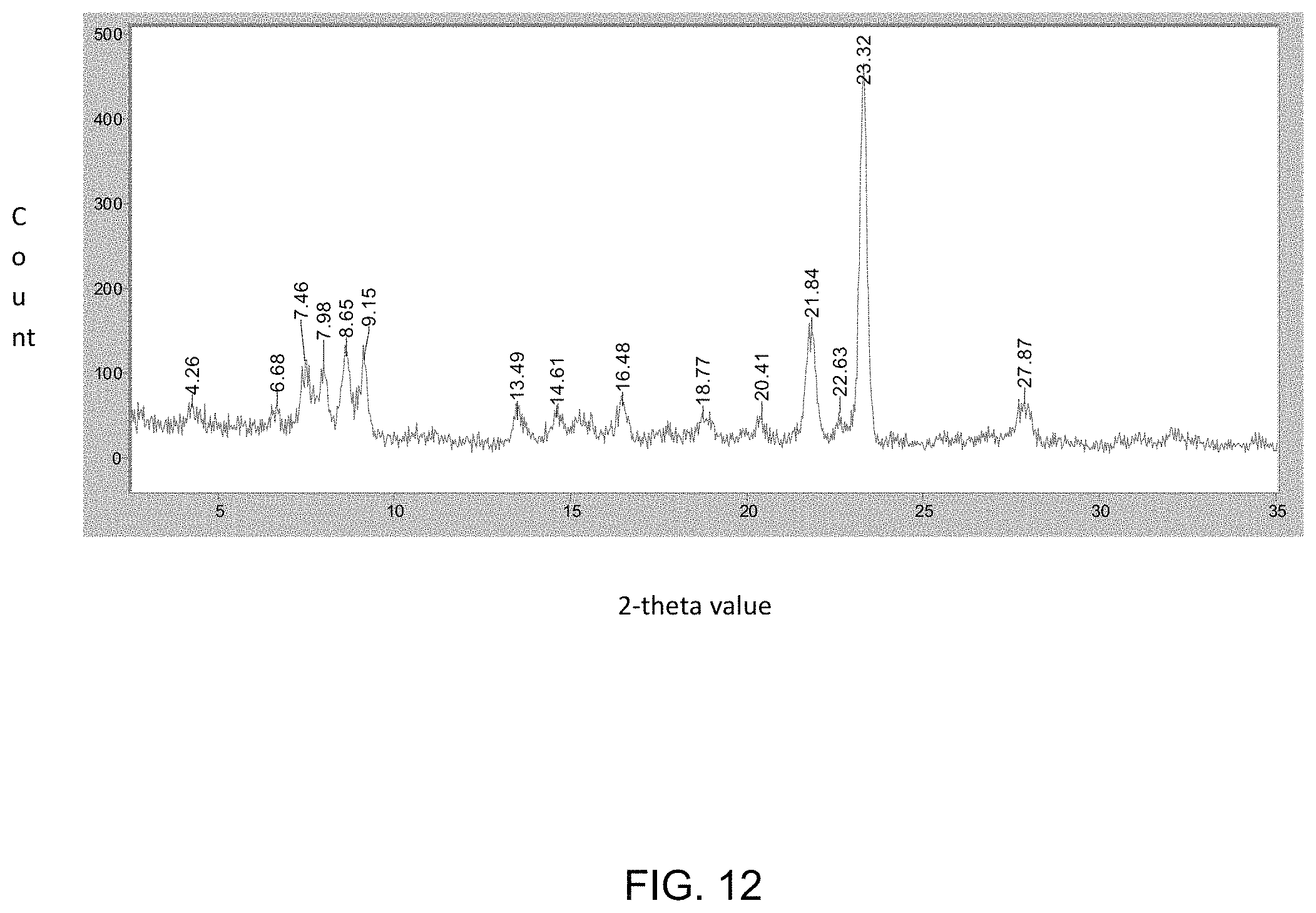
D00013

D00014

D00015
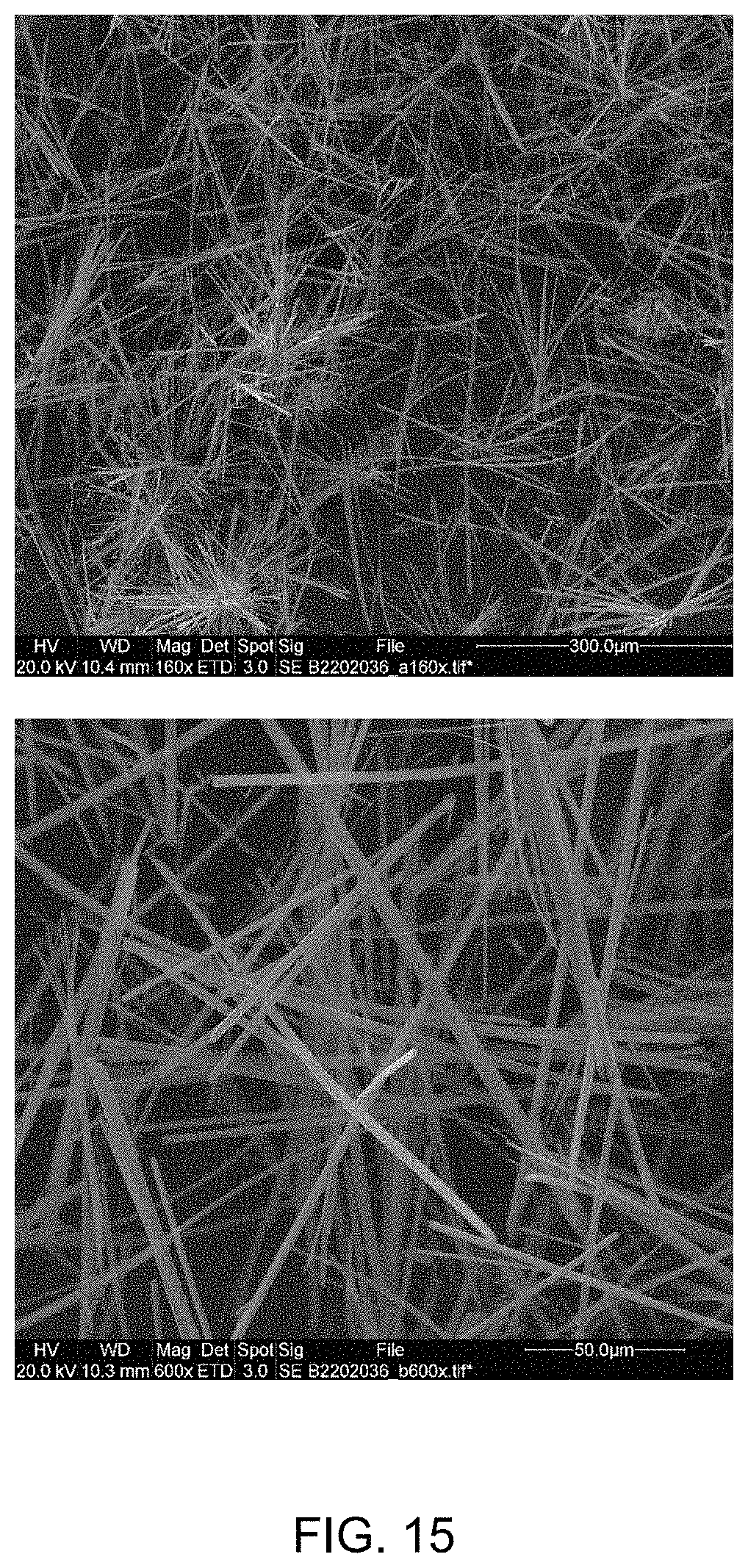
D00016

D00017

D00018
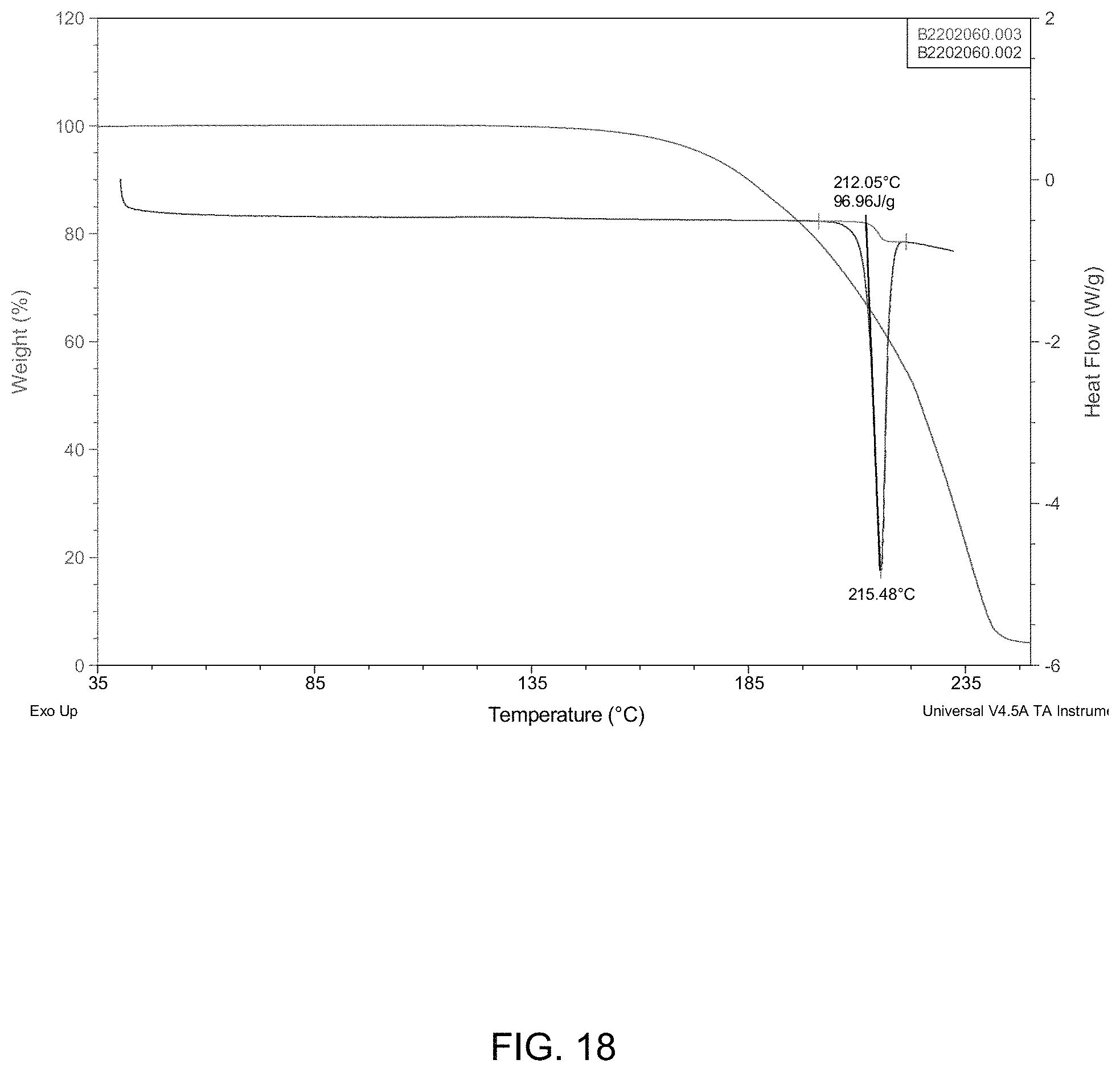
XML
uspto.report is an independent third-party trademark research tool that is not affiliated, endorsed, or sponsored by the United States Patent and Trademark Office (USPTO) or any other governmental organization. The information provided by uspto.report is based on publicly available data at the time of writing and is intended for informational purposes only.
While we strive to provide accurate and up-to-date information, we do not guarantee the accuracy, completeness, reliability, or suitability of the information displayed on this site. The use of this site is at your own risk. Any reliance you place on such information is therefore strictly at your own risk.
All official trademark data, including owner information, should be verified by visiting the official USPTO website at www.uspto.gov. This site is not intended to replace professional legal advice and should not be used as a substitute for consulting with a legal professional who is knowledgeable about trademark law.